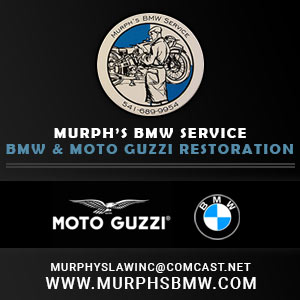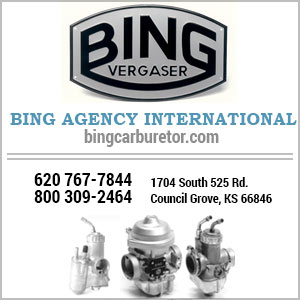1978 R80/7 engine suddenly quits running at speed.
On several occasions, months apart, my R80/7 suddenly shut down while cruising at 65 mph, no sputter, no cough, just quiet. After coasting to the side of the road and waiting a couple of minutes, it cranks right up and runs normally again even at high speed and under load up hill. The fuel is clean in the carb bowls; battery ground is clean and tight; new points and condenser. This "shut down" experience happened both before and after I put in new points and condenser and adjusted valves and balanced carbs. What is shutting her down at speed out of the blue? I would really appreciate some advice. Best.
Intermittent issues like this are the hardest to find because they leave no trace after the fact.
There are many suspects within the fuel and electrical system that can have this effect. If you feel like the cutoff was rather abrupt, rather than (say for instance) spread over 1/4 mile, then that points to the electrical system. Electrical issues can be fairly daunting on their face, but you need to remember that the electrical system is comprised of 3 totally separate "systems" wrapped into a single harness: charging, lighting, and ignition. Of these 3, the ignition system is probably the smallest and easiest to deal with.
The first order of business is to obtain a clear electrical schematic for your model year. Starting at the coil, trace back toward the handlebar "kill" switch. Power for the ignition typically starts at the handlebar switch... which means that the first items to check are the wires and connector that connects the handlebar switch to the main harness. This connector controls power into AND out of the "kill" switch. So there, in that single location are two (2) chances to cut off your ignition. Probing with a simple test light while operating both the ignition switch and "kill button" DOZENS of times will sometimes help you spot a device that is not making a perfect connection.
Kill buttons are the second most favorable suspect because most owners never use them. Modern switches clean themselves via a wiping action. But, if you never use the switch then it never gets cleaned. (In the same vein... your horns will be louder, and their action more positive, if you'll simply have the presence of mind to blow the horn ~15 times during every ride !) Obviously, the ignition switch gets lots of use, but they have the opposite issue.... that of simply being worn out from 40 years of use. Problems in this switch usually show up first in the form of flickering headlamps, well before owners recognize that their ignition is also failing.
Finally, early models of the dual plug wire coil are known to have issues. You might want to do some research on that end. In the back of my mind something is telling me these coils were blue in color, but don't hold me to it.
► Finally, my experience as a professional vintage motorcycle mechanic simply tells me that it is very poor practice to re-connect any wire, connector, plug, or relay without coating the electrical contacts with a corrosion fighting, electrical connection enhancing compound, such as No-Ox-Id. Since the corrosion that usually accompanies 40 year-old motorcycle electrical connectors is usually microscopic, it's most cost effective (e.g. "best practice") to spend 1 penny per contact being sure today and adding future prevention.
Hope this helps.
Owning an old Airhead is easy.
Keeping an old Airhead running great is the true test.
I’ve got the same year/model, not an uncommon problem for us!
All great advice from Wobbly. Quote: “Power for the ignition typically starts at the handlebar switch...”, OK agreed, but these models have a known weak link, which I think is prudent to inspect first off!
This model use the ATE brake system, with the Master Cylinder = MC, located under the fuel tank. Remove the gas tank and look on the left side of the frame backbone, under the MC, and locate the Starter Relay = SR, (that square cube). First off, inspect the MC, and area below, for brake fluid leakage/spillage. It might be time to deal with your MC, you make the call? Regardless of what you find now, previous corrosive brake fluid from leaks/spills can ended up inside the SR contacts and has silently done its dirty work.
It’s not obvious at first, but electrical power for these models pass through this SR. Find your schematic then trace the electrical paths starting at the battery, it will all become clear (well, as clear as multi-colored Spaghetti).
Unplugging and re-plugging the SR might help if you’re stuck out on the road.
But at home inspect and clean all the SR contacts really good, then use a good anti-corrosion product such as No-Ox-It. Tip: I find female connectors especially captured inside a connector plug a challenge to clean. So for bad corrosion and aggressive cleaning try emery cloth cut to size and folded to become double sided, which then inserts nicely, make several strips as new ones insert best. For less aggressive cleaning and protective coating applications those mini dental brushes with bristles, (available next to most toothbrush displays), insert perfectly.
Please indulge me while I go on a personal rant here: Before you consider using dielectric grease on your connectors, please do your research. You will find it is an insulator = non-conductor. Then think real hard about if you want to use an insulator on electrical contacts whose main purpose is to conduct electricity. Yea everybody does it, but as your mother likely said: “Would you jump off that bridge too, just because….”. If you do go the dielectric grease route, just remember, more is not always better and the words “use sparingly” really means use half of what you think is sparing!
Now the second issue we seem to have with these models, inspect all the wires outside the wire loom around the SR, one wire in particular likes to vibrate causing breakage/chafing problems. For future avoidance it might be prudent now to secure, the loose/dangling wire typically found there. Vaguely I remember someone offered the advice to make some sort of padding to isolate the wire from rubbing, but you’re on your own there.
Hope that helps! If not continue on with Wobbly’s approach.
PS: Regardless of what you find, DON”T STOP NOW but continue to CLEAN and PROTECT - ALL those (40+ year old) electrical contacts, then your bike will silently love you back.
My bad. Mr. 14295 is very correct.
Leakage of any brake fluid over the last 40 years can and will cause electrical issues, but most especially with the 1978, 1979, and 1980 models which use the small "mini cube" type starter relay.
Owning an old Airhead is easy.
Keeping an old Airhead running great is the true test.
Thanks for this thoughtful reply. I will remove the tank and follow this advice. I want to keep confidence in this old girl. Best, jaburger
Thanks a bunch, Wobbly, for all the great advice. I will follow through and check all those connections. Best, jaburger
- 27 Forums
- 1,900 Topics
- 10.8 K Posts
- 1 Online
- 5,936 Members





